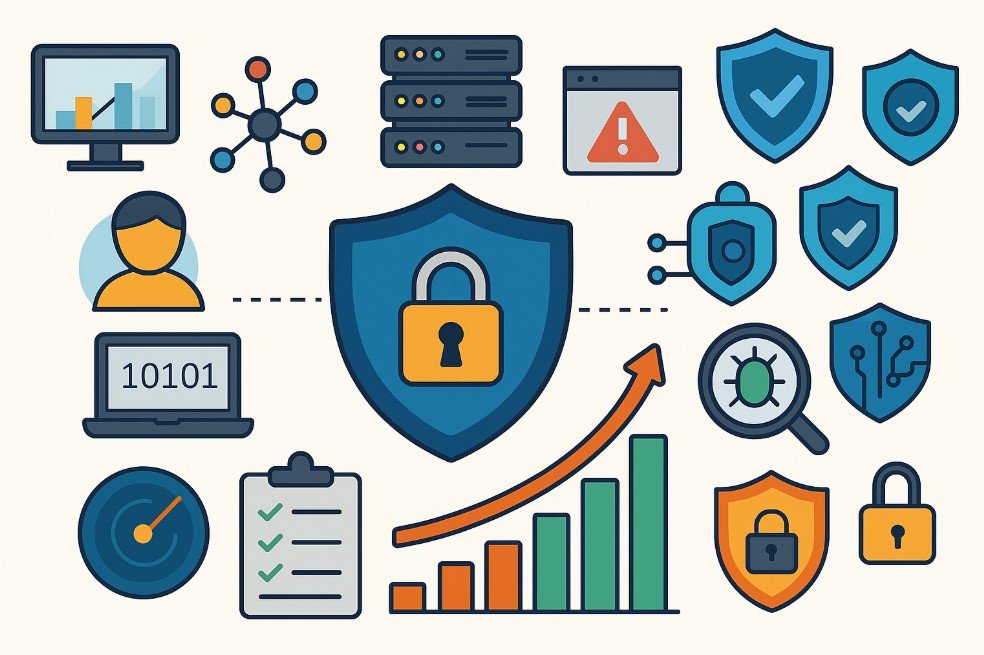Tech
7 Cybersecurity Frameworks to Reduce Risk in 2025

Changes in the cyber environment are happening rapidly in 2025. Today’s cyber attackers use sophisticated approaches. Firms now handle more serious problems than in the past. Hits on critical infrastructure, as well as attacks on supply chains and ransomware, are serious dangers.
Dealing with these threats calls for a reliable information security risk management system. This framework helps identify weaknesses and reduce threats. It also promotes resilient security practices. Additionally, it adapts to new threats and meets regulatory requirements.
This article examines seven cybersecurity frameworks. They provide practical methods to cut risks and improve security in today’s evolving threat landscape.
Understanding Cybersecurity Risk in 2025
The threat landscape in 2025 shows a rise in advanced, AI-driven attacks and more cloud vulnerabilities. As people use remote work and connected devices more, old defenses won’t work as well. Businesses must use clear approaches to recognize, prioritize, and control risks.
Why Cybersecurity Frameworks Matter
Cybersecurity frameworks bring consistency and clarity to security planning. They allow organizations to assess vulnerabilities, establish controls, and track progress. A good cybersecurity risk management framework aligns IT actions with business objectives while minimizing blind spots.
Strategic Alignment with Compliance Goals
Frameworks help navigate overlapping requirements from regulators, insurers, and partners. They also create a foundation for incident response and recovery. When used correctly, they enable proactive security rather than reactive problem-solving.
-
NIST Cybersecurity Framework: CSF 2.0
The Cybersecurity Framework created by the National Institute of Standards and Technology is required by organizations everywhere. The framework is built around five functions that work together in a constant cycle.
NIST Core Functions
The framework begins with Identify, where organizations inventory assets and understand security risks. Protect establishes safeguards for critical services, while Detect focuses on identifying security events. Respond guides containing incidents, and Recover helps restore impaired capabilities.
Implementation Strategies
Organizations often start with a gap analysis comparing current practices against framework recommendations. Small businesses can implement key controls. Enterprises may integrate the framework with their current security programs. Many organizations see value in mapping security controls to various frameworks. NIST CSF often serves as the main reference.
-
ISO 27001
Setting up, maintaining, and improving an Information Security Management System requires a clear, structured approach. The ISO 27001 risk management framework outlines this process in detail.
ISMS Approach
The ISMS methodology centers on understanding the organization’s context. It also defines the security scope and establishes leadership commitment. The standard requires organizations to assess information risks systematically. They must then implement security controls based on the results of the risk assessment.
Certification Process
Organizations seeking certification must have their documents reviewed. They also need onsite audits by accredited certification bodies. Certification proves a company meets international security standards. This can give a competitive edge in security-focused markets. To maintain their certification, they must undergo regular surveillance audits. They also require a full reassessment every three years.
-
ISO 27002
Detailed implementation guidance for security controls is provided through a complementary standard. The ISO 27002 complements ISO 27001 outlines best practices across multiple security domains. These practices help organizations apply and manage safeguards effectively.
Security Controls Catalog
The controls span organizational, people, physical, and technical measures. Organizations usually choose controls based on risk assessment results. They don’t apply all controls the same way. The 2022 revision streamlined controls into four categories: organizational, people, physical, and technological.
Adaptation Strategies
Organizations should tailor controls to their specific needs rather than applying generic implementations. Controls must match the identified risks and business goals. Set implementation priorities based on risk levels and available resources. Regular reviews ensure controls remain effective against evolving threats.
-
CIS Critical Security Controls
The Center for Internet Security Controls offers key security steps for organizations. These actions help boost their overall security.
Implementation Tiers
CIS organizes controls into implementation groups based on organizational complexity and capability. Implementation Group 1 has basic controls that every organization needs. Groups 2 and 3 introduce more advanced measures.
Essential Security Actions
CIS Controls focus on high-priority defensive actions that address common attack vectors. Organizations should begin with inventory controls for hardware and software assets. Next, they should focus on ongoing vulnerability management. They also need to control the use of administrative privileges. Security researchers say that using the top six controls can stop about 85% of common attacks.
-
SOC 2
The purpose of this framework is to help service firms protect their customers’ information. Its main principles are security, confidentiality, privacy, availability and data processing integrity.
Trust Service Criteria
Organizations typically begin with the security category (Common Criteria) as the foundation. Additional criteria can be added based on specific business services and client requirements. The framework emphasizes both technical controls and governance processes.
Compliance Program
To build a SOC 2 compliance program, define system boundaries first. Then, identify the relevant trust criteria. Next, implement the necessary controls. Organizations must keep proof of how well these controls work. This is especially important for Type 2 assessments, which check controls over time. Regular internal assessments help identify gaps before formal audits.
-
PCI DSS
The Payment Card Industry Data Security Standard keeps cardholder data safe. It applies to organizations that store, process, or send payment information.
Requirements
PCI DSS requires:
- Building secure networks
- Protecting cardholder data.
- Managing vulnerabilities.
- Implementing access controls.
- Monitoring networks.
- Maintaining security policies.
Version 4.0 introduced significant updates focusing on authentication, encryption, and security testing.
Scope Management
Organizations should minimize their cardholder data environment through network segmentation and data minimization. Reducing scope decreases compliance complexity and potential breach exposure. Validation requirements depend on transaction volume. Bigger merchants have stricter assessment obligations.
-
HIPAA Security Rule
Healthcare organizations must follow the HIPAA Security Rule. This rule protects electronic protected health information – ePHI.
Safeguards
Risk analysis, security guards and managing who can access the system are considered administrative safeguards. Buildings and equipment are safeguarded by physical measures. Some technical safeguards are access controls, audit controls and security surrounding data transfer.
Risk Analysis
Organizations are required to analyze risks in detail. As a result of these analyses, potential dangers to the privacy, safety and usability of ePHI can be found. Written proof of security actions and how they are put in place demonstrates that you are following regulations. Performing regular security checks will improve your security. This responds to recent problems and any changes that take place within the organization.
Choosing the Right Cybersecurity Risk Management Framework
No single framework works for every situation. Some of the practical points worth considering include:
Industry requirements
Sectors like healthcare, finance, and defense may require specific frameworks or certifications.
Existing controls
A framework that aligns with your current controls can minimize implementation friction.
Scalability
Ensure the framework supports both present and future growth without constant overhauls.
Audit readiness
If compliance audits are frequent, consider frameworks that streamline documentation and assessment.
Choosing a cybersecurity risk management framework is also about maturity. Begin with basic models like CIS Controls or NIST CSF. Then, as your organization grows, move to more advanced options like ISO 27001 or FAIR.
Conclusion
Cybersecurity risk management frameworks assist organizations in safeguarding their most important assets and remaining compliant. Every framework has its advantages. Most organizations blend pieces from multiple frameworks. They do this to suit their particular needs.
Utilizing these frameworks enables security teams to establish priorities, designate resources, and enhance security programs. Success depends on ongoing refinement. It involves regularly reviewing practices, addressing weaknesses, and adjusting to emerging threats.
-

 Business2 months ago
Business2 months agoTech Capital One: Careers, Jobs, and Opportunities
-

 Digital Marketing2 months ago
Digital Marketing2 months agoHow Embedded Payments Are Turning Apps Into Revenue Engines
-

 Tech1 month ago
Tech1 month agoSora 2 Invite Code: How to Get One (Step-by-Step Guide)
-

 Real Estate2 months ago
Real Estate2 months agoDigital Tools That Are Changing the Way We Relocate






